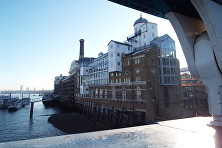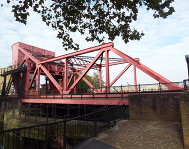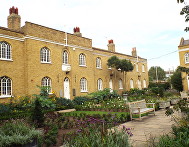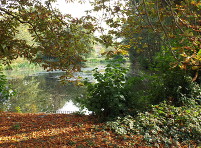





Exploring Southwark and discovering its history


It had, for many years, been the Mission’s dream to build a small hospital but the costs involved made it prohibitive. Then they hit upon the bright idea of buying a disused army hut which they would refurbish for use as a small hospital. In March 1921 they located such a hut in Epping Forest which they transported back to Bermondsey and re-erected in The Oasis. Named The Hospital in the Oasis, the ward had five beds and two cots. In addition, there were two beds set aside for women with small means who were unable to pay the high fees of nursing homes. The new hospital was full all the time and most patients admitted, both women and children, were seriously ill. During the first year, 96 women and 32 children were admitted.
The Mission celebrated its 21st anniversary in 1925. Since opening there had been 261,849 attendances, 64,331 home visits, 105,450 surgical dressings applied and 1,567 operations. The number of staff serving the Mission had grown considerably: the 1926 Annual Report shows, in addition to Dr Fox whose title is shown as Honorary Physician and Director, there was an Honorary Consulting Surgeon, a Visiting Surgeon, a Resident Medical Officer, a Resident House Surgeon, a Visiting Physician, and individual physicians in charge of the Ophthalmic, Nose and Throat, Venereal Diseases, and Gynaecological Departments, a Matron, two Nursing Sisters, an Assistant Nurse, a Night Nurse, a Dispenser and an Assistant Dispenser.
The women of Bermondsey were very thankful for the Mission’s work and did not know what they would do without their presence. The 1926 Annual Report recorded some of their comments:
“You treats us all as friends – not as cases.”
“We do enjoy them little readings and singings whenwe’re waiting for the medicines – they seem to brighten and cheer us up for days – and the stories sticks in my head all the week, and I feels the better for them.”
The same report showed an income that totalled just over £1773 for the year with donations received from numerous individuals that included members of the Bevington family and Arthur Carr, Chairman of Peek Frean's (who also provided the means for a dental surgery in 1930) and from local companies such as Crosse and Blackwell, Jacobs Biscuits, Peek Frean's and Hartley’s Jams.
During the same year, the King Edward VII Fund had also made an offer of financial support if the hospital could be rebuilt as a permanent structure which proved a huge incentive to raise funds. In April the following year, with the necessary money raised, the commemoration stone laid. The new hospital was officially opened on Saturday 4 May 1929 by the Duchess of York (later Queen Elizabeth, the Queen Mother) who was greeted with great enthusiasm. She made a tour of the whole Mission and spoke to every patient. Lena Fox described the occasion: “The wonderful afternoon of beautiful sunshine inside and out came to an end, but one feature of it remains permanently for the remembrance of Her Royal Highness’s genuine kindness and practical sympathy and interest in this women’s work for women and children will ever live in the hearts of all who saw her.”
When World War II broke out in September 1939, the Mission was commandeered and equipped by Bermondsey Borough Council as a First Aid Post until it was moved to Bermondsey Baths. At the beginning of the war, a lot of time was spent by the medical staff in air raid shelters, both as a safety precaution for themselves and to attend the injured and ill. Many of the Mission’s regular patients had been evacuated but treatment including casualty and surgical dressing work increased. As had been the case during the First World War, it was an extremely challenging time for the Mission.
Following the ending of the war and upon the foundation of the National Health Service, the Bermondsey Medical Mission Hospital was taken over by the Department of Health in 1948, although the Mission continued general practice and social work from the premises. Many Bermondsey families had been rehoused outside the area after the war which had led to a large proportion of elderly within the area who became the focus of the Mission’s work. The money received by the Mission for the transfer of the hospital to the NHS was used to establish a facility in Bromley that provided care for older people. The Mission had previously set up clinics in Downham and Mottingham before the war and these also now provided care for the elderly, and further establishments offering similar care were opened in the 1950s and 1960s.
The Mission was able to buy back their hospital in Crimscott Street in 1958. It was renamed Lena Fox House and reopened to provide care for the elderly that included a community centre and social club. Sadly, Dr Selina Fox, who had provided the inspiration and drive for the Mission for over 50 years, died in the hospital in 1958.
Sources:
The Story of the Bermondsey Medical Mission 1904 – 1947 by Selina F Fox (available at the Southwark Local Studies Library)
Lost Hospitals of London website
Mission Care website
Bermondsey Medical Mission Annual Reports for 1926 and 1940, downloaded from the Mission Care website.
For a small fee, the newly opened mission dispensary offered out-patient care and treatment to women and children who otherwise were unable to afford medical treatment. During first 12 months of the Mission opening, there was a total of 22,392 attendances at the Clinic from a total of 5,447 patients and 6,798 visits paid to patients in their own homes. At the beginning of every session, a short religious service was held and at Christmas the usual festivities held.I n the Autumn of the first year, the first Harvest Festival was held and though there were “no harvest fields in Bermondsey, the Hall was packed to overflowing and decorated with many gifts, loaves, fruit vegetables and flower sent by friends of Mission and by patients themselves.”
A Samaritan Fund was set up with enabled parcels of warm clothing, groceries and milk tickets to be distributed to many destitute and poverty stricken families within Bermondsey and to enable invalids and convalescents to go to the seaside or the country to hasten their return to health. This was at a time when the Bermondsey air was heavily polluted with emissions from the many factories and tanneries, when there were few trees or open spaces. Attendance at the clinic and the number of patients rose considerably over the next few years, accompanied by an increase in the number of staff and helpers.
An appeal was launched at the end of 1908 to raise the necessary money to purchase the freehold. The appeal met with a generous response but no sooner had the freehold been acquired when Dr Martin, their neighbour at no. 45 Grange Road, erected a tarred hoarding 70 feet long and twenty feet high that extended the whole length of the Dispensary within the 2 feet six inches of the windows thus shutting out light, sunshine and air. Dr Martin said it was from no hostility to the Mission but that the landlord (he was unaware that the Mission now owned the freehold) had been enjoying light and air across his garden for years without paying for it! Clearly this high fence was not acceptable for the Mission and as a result they purchased from Dr Martin a plot of vacant land to the west of the Dispensary that fronted onto Crimscott Street and acquired a strip of land 10 feet wide from Dr Martin’s garden. This not only prevented a further high fence being put up but the Mission were able to double the size of the out-patients department by the addition of further rooms and for the clinic to have an entrance from Crimscott Street.
The new facilities were opened on 14 June 1910 by the Bishop of Southwark who paid tribute to the “benefactor” whose actions had given rise to the improvements, who he referred to as the” hero of the tarred hoarding.” He went on to say that “Benefactors were an exceedingly remarkable race, but he did not think a more ingenious method of benefaction would go down to history than that gentleman’s whose hoarding had been largely responsible for what they saw that day.” (Daily News, 14 June 1910)
A few months later, Dr Martin advised the Mission that he was in discussion to sell some land that was laid out with trees, shrubs and a lawn to the rear of his property to pickle and sauce manufacturer E Lazenby & Son to extend their premises. The prospect of this overwhelmed the Mission and, as a consequence, purchased the land themselves. The newly acquired plot of land became known as the Oasis and was immediately put to use for benefit of staff and patients.
Bermondsey Medical Mission
The Bermondsey Medical Mission, based in Grange Road and Crimscott Street, was opened in 1904 and, until it was taken over by the newly formed National Health Service in 1948, was literally a life saver for many thousands of women and children. It was the result of the vision and dedication of Dr Selina “Lena” Fox that was motivated by a strong Christian faith to provide both physical and spiritual care to the poor of Bermondsey.
The Bermondsey Medical Mission's newly built hospital with an entrance in Crimscott Street, 1929 (Photo Credit: Welcome Library, London)
Dr Fox came from a middle class background and was born in Blackheath in 1871. Her father, Sir Francis Fox, was a consulting engineer and was to be a huge support to his daughter and clinic over the years. Lena qualified as a doctor in 1899 having studied at the London School of Medicine and the General Infirmary in Newcastle-upon-Tyne. A year after qualifying and with experience gained at the Church Missionary Society Mission in Riley Street, Bermondsey, she took up a post as assistant medical officer with the Zenana Bible and Medical Mission in Lucknow, India. She stayed in India only for a short time as her health failed in the hot climate and she returned to the Mission in Bermondsey. After three years, the Church Missionary Society made the decision to close the Bermondsey Mission but Dr Fox, who clearly felt passionate about the work, persuaded the Society to continue its work by agreeing to be responsible for the its maintenance and development. To this end, a small committee was formed which included herself and her father.
Their first task was to find suitable premises but the search was not easy until, when taking a final tour of the area, Dr Fox and her father came across a man posting a notice in a window of the house at 44 Grange Road announcing “This house to let: apply within.” They asked to see inside and the premises consisted of an old well-built residential house with small garden and back yard. At the end of the garden there stood a dilapidated stable and a small burnt out factory. They imagined what could be achieved there and took on a lease on 4 March 1904 with option of purchasing freehold within 5 years.
None of what they had leased was suitable for the actual medical work and so they “decided “with a feeling of awe” to build a Dispensary on the land to the rear of the house which would consist of a well warmed hall capable of seating about a hundred and twenty patients, two adjacent rooms leading from the hall as consulting rooms, a third as a surgery for the nursing sister and a fourth as a fully equipped dispensary for the two dispensers. There would also be a small kitchen for preparing tea for the patients waiting to see the doctors or for providing soup in the winter to underfed patients and children.” The building was completed within six months and while the building work was underway, medical work was carried out in the South London Sunday School Mission with its hall and class rooms in Abbey Street. Staff took up residence in the main house on 28 March 1904 and with Dr Fox as lead doctor there were also Assistant Doctor, Nursing Sister, Dispenser, Assistant Dispenser, Assistant Nurse and Cook-Housekeeper.
The newly built Dispensary was opened on 29 October with a short religious service attended by over a hundred interested friends together with representatives from all denominations and many of the other missions in Bermondsey.
It was used for recreation, games, mothers’ tea parties and gatherings in the Summer and Lena Fox wrote later that it became a real joy to many tired women and it was touching to see the pleasure evinced at the sight of the grass and trees and simple flowers. Often, wrote Dr Fox, in the quiet summer evenings this patch of green among the grey roofs and walls recalled the well known words “A garden is a lovesome thing.”
Though the Mission faced daily challenges, the outbreak and duration of the First World War proved a most testing period. Dr Fox was appointed to the post of Deputy Governor, and later Governor and Medical Officer of Aylesbury Women’s Prison which necessitated her moving away from Bermondsey although she visited the Mission as often as she was able and the Mission continued its work. 1916 proved a year of extreme economy together with shortage of staff and for the first time had to close its doors for a month in Summer as locum doctors could not be found. Selina Fox wrote about the following year:
“1917 was an anxious year, the Mission uncertain whether it could continue. Rising prices, falling funds, shortage of staff, strain of air-raids were a few of the obstacles that beset our path. But it had become an institution in the district and the great need of the women and children was uppermost in our minds for as they said, “It is a comfort to have someone to turn to in distress and perplexity.” So the work was continued quietly with the help of a band of loyal friends.”
She goes on to describe an example of how the people of Bermondsey gave their support:
“It was the practice of the employees of a large jam factory in Bermondsey when the day for the annual profit sharing came around to vote a sum towards the funds of the Mission. This year they voluntarily doubled the amount, not only as a sign of their gratitude for the kindness shown to so many women workers and their children but also to indicate their realisation of the immense advance in the cost of upkeep.”
As the war neared its end, there were anxieties of another kind as it was proposed in some quarters that everything would be nationalised which would lead to the end of medical missions, but in the event this was not to happen until 30 years later. Dr Fox described the renewed hope at the end of the war: “soon the dawn of a new day broke in upon us; hope returned and we looked forward to brighter days and renewed activities.”
Dr Selina Fox in her study.
(Photo Credit: Welcome Library, London)
The organisation’s name was changed to Mission Care in 1991 to reflect their changing role within the community. A year later, Lena Fox House in Bermondsey was closed due to high maintenance costs and became a hostel for homeless young people aged between 16 and 26 years run by the Shaftesbury Society. It has since been taken over by St Mungo’s charity for the homeless.
Web discoveries
- UK Casino Not On Gamstop
- UK Casino Not On Gamstop
- Non Gamstop Casino
- Casinos Not On Gamstop
- Non Gamstop Casinos
- Non Gamstop Casinos
- Non Gamstop Casino
- Casinos Not On Gamstop
- Casino Sites Not On Gamstop
- Slots Not On Gamstop
- Casinos Not On Gamstop
- UK Betting Sites Not On Gamstop
- UK Casino Not On Gamstop
- Best Non Gamstop Casinos
- Betting Sites
- Non Gamstop Casino Sites UK
- Best Non Gamstop Casinos
- Non Gamstop Casino
- Casinos Not On Gamstop
- Non Gamstop Casino Sites UK
- Horse Racing Betting